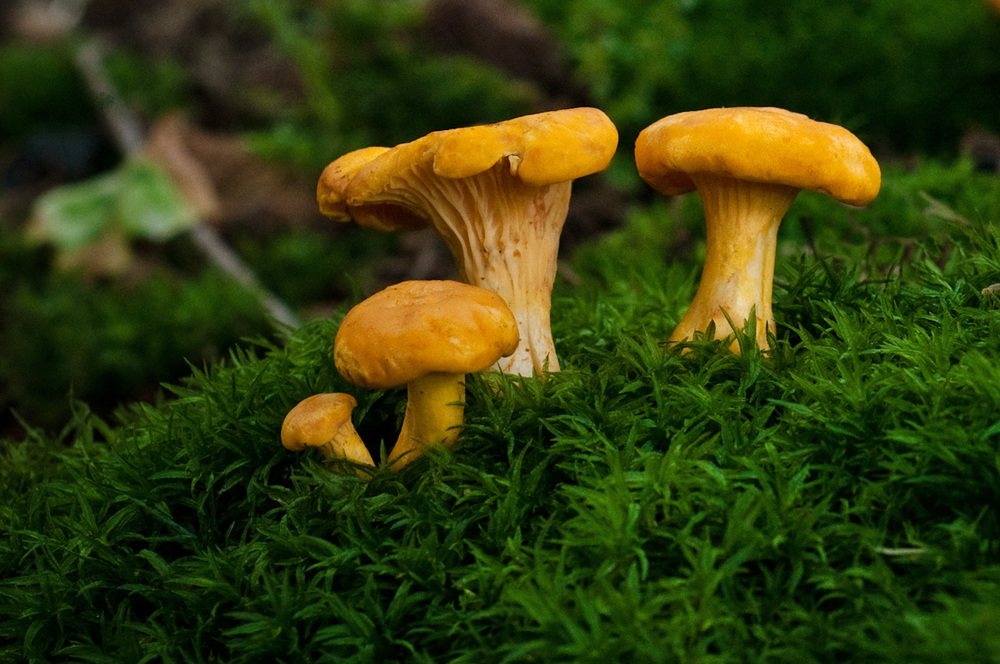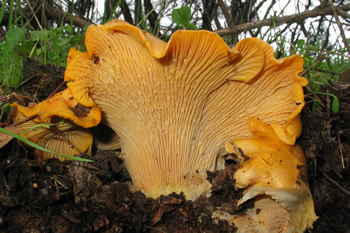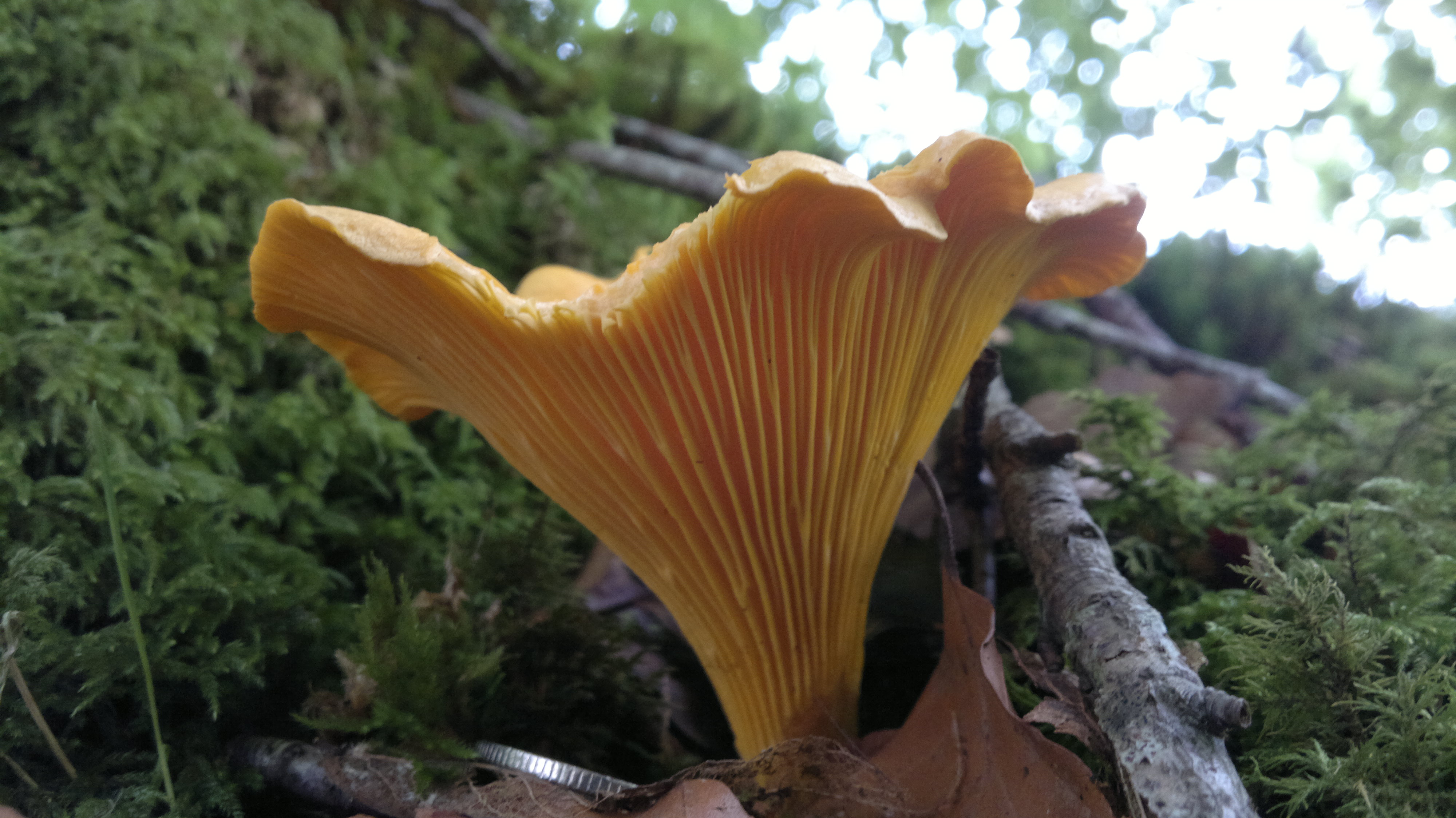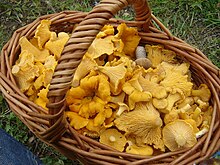Chanterelle
Golden Chanterelle ( Cantharellus cibarius )
The real chanterelle, chanterelle or Rehling ( Cantharellus cibarius ), also chanterelles, in Austria and Bavaria chanterelle and Reherl next Eierschwamm called in Switzerland, chanterelles, is a fungus of the genus chanterelles ( Cantharellus ).
- 4.1 Edible Mushroom
- 4.2 phrase
- 4.3 Stamps
- 7.1 Notes and references
Features
The characteristic features of the real thing are chanterelle shape and color of the pileus and stipe of the fruiting bodies. The yolk - yellow to golden hat has 2-9, rarely up to 15 centimeters in diameter, initially has a hemispherical to convex shape, which then inverts to a funnel-shaped. The brim is irregularly wavy and often inflected later. The Hutunterseite is covered with comparatively low and more or less broad, often forked and anastomosing ( interconnected ) strips that run down far on the stem and gradually fade it. The hutfarbene stalk is short ( 3-6, rarely up to 8 inches long ), usually 1 to 2 centimeters thick, often curved, tapering downward and gradually going up into the hat and raise plump. The flesh is crisp firmly, in the stalk tough and fibrous, whitish colored to pale yellow (hence the word origin) tastes mild to peppery and smells with fresh copies fine fruity ( apricot ). The spores appear en masse as a pale yellow spore powder, measuring 8 to 10 at 4.5 to 5.5 microns and are ellipsoidal in shape. They show no color reaction with Iodreagenzien ( inamyloid ).
Ecology and phenology
The Real Chanterelle is a mycorrhizal fungus which enters symbioses with various coniferous and deciduous trees. In Central Europe the preferred partner is the common spruce tree, followed by the European beech. In addition, the fungus can be associated with oak, pine and fir trees. The Real Chanterelle colonized various types of forest on moderately dry, base- and nutrient-poor soils. In limestone areas only superficially acidified soils are colonized. It often grows very sociable in young plantations and more or less openly, only sparse grasses, shrubs and moss -covered bodies.
The fruiting bodies of Real Chanterelle appear in central Europe from June to November.
Dissemination
The Real Chanterelle is found in Australia, South America, North Asia, North America and Europe. In Europe, the chanterelles is widespread.
Portfolio development and risk
The Chanterelle was formerly a very common fungus, but shows in Germany for some time (about the beginning of the 1970s ) significant decline trends. The cause for the decline of the type of air pollution is suspected. The Pfifferlingsmyzel very sensitive to sulfur dioxide. Ozone inhibits sporulation. Other risk factors are nitrogen inputs, longtime lack of precipitation, groundwater depletion, forest operations and soil compaction by forest machines and much trodden forest areas. For Baden- Württemberg chanterelle in the risk group G 3 is (still common, but significant decrease tendency) classified.
Also in Austria, the chanterelle is endangered and therefore protected in all provinces so far. Usually this means that similar to other fungal species may be harvested up to a maximum of 2 kg only from private chanterelle.
Importance
Mushroom
The Real Chanterelle is a popular edible mushroom since ancient times and is traded in large quantities. In Germany offered chanterelles are mostly from East-Central European, Baltic and Eastern European countries.
Chanterelles should not be eaten raw because the cell walls contain chitin.
Phrase
With: "This is ( to me ) not worth a damn! " Pressing colloquially low esteem towards an object or a person from. Whether there is a connection between the phrase and the fungus is controversial. The assumption that the phrase on the (over) abundant supply of this fungus is due in earlier times, although is obvious; but more likely is the origin of the southwest German dialect, where a five -pfennig piece Pfifferle means. "So a false chanterelle " is likely to be originated from the confusability with just this and thinks usually a person dodgy character.
Stamps
Stamp from Romania ( 1958)
Stamp of Moldova ( 1995)
Stamp from Soviet Union ( 1964)
Variability
The Real Chanterelle varies greatly, Corner (1966 ) leads the world up to 18 different varieties. Krieglsteiner (2000) has only two varieties taxonomic rank conceded that now have the species level: Violettschuppiger chanterelle ( Cantharellus amethysteus ) and Pale chanterelle ( Cantharellus pallens ). In contrast, recognize Eyssartier & Buyck (2000 ) next to the Typusvarietät seven taxa:
Artabgrenzung
Confusion is possible in principle with other species of the genus chanterelles, the false chanterelle ( Hygrophoropsis aurantiaca ) and the very rare in Germany olive tree fungus ( Omphalotus olearius ).










